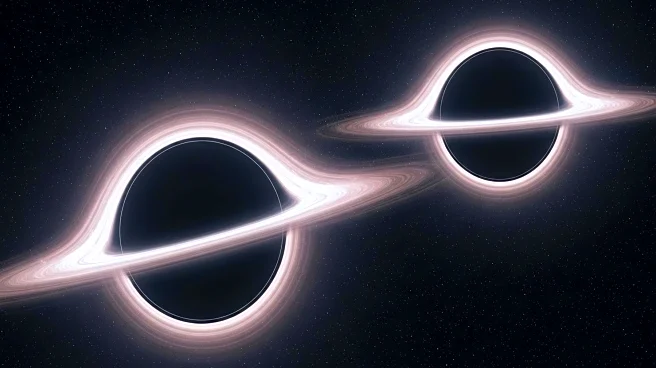What is the story about?
What's Happening?
Astronomers have successfully captured the first-ever image of two black holes orbiting each other, providing definitive proof of a phenomenon long theorized but never visually confirmed. The image, taken by a network of radio telescopes including the RadioAstron satellite, reveals two supermassive black holes within the quasar OJ287, located approximately 5 billion light-years away. The larger black hole has a mass 18 billion times that of the sun, while the smaller one is about 150 million times the sun's mass. This discovery complements previous indirect evidence from gravitational wave detections, offering a direct visual confirmation of binary black holes.
Why It's Important?
This groundbreaking discovery has significant implications for our understanding of black hole dynamics and the evolution of galaxies. By confirming the existence of binary black holes, scientists can better understand the processes leading to their formation and eventual mergers, which are key events in shaping the universe. The ability to visually resolve these black holes also enhances our capability to study the extreme conditions around them, potentially leading to new insights into the behavior of matter and energy in such environments. This could impact theories on galaxy formation and the role of black holes in cosmic evolution.
What's Next?
Researchers will continue to monitor the quasar OJ287 to observe the ongoing interaction between the two black holes. Future studies may focus on capturing more detailed images and data to understand the dynamics of their orbit and the effects on surrounding matter. The findings may prompt further exploration using advanced telescopes and satellite systems to identify other binary black hole systems, potentially leading to new discoveries about the universe's structure and the role of black holes in cosmic phenomena.
Beyond the Headlines
The discovery of binary black holes orbiting each other opens up new avenues for research into the fundamental physics governing these massive objects. It challenges existing models of black hole formation and interaction, suggesting that such systems may be more common than previously thought. This could lead to a reevaluation of the frequency and impact of black hole mergers in the universe, influencing theories on gravitational waves and their detection.
AI Generated Content
Do you find this article useful?

















